| by Rakesh Rampertab |
See here for more images on Leonora estate See here for article on History of Leonora
Long before March 6, 1964, a young East Indian
woman named Sumintra, a weeder, and two other workers at the Leonora
sugar estate were shot dead by colonial police, after a “disturbance”
(to please the description of the “white” press) in
February 1939 (1) (click to see disturbance newspaper images 1
and 2) . Nothing
was even written about these people, except a mention of their
names in the paper the following morning. From the newspaper article,
it is obvious that the situation was very debilitating for the
sugar authorities. For the sugar workers, it was very significant.
It would lead to the new union, the Man Power Citizens Association
(MPCA) being recognized by the colonial government as the first
representative of the sugar workers.
But I believe the pain must be endured, from which the history of all people who struggled against the British sugar authority ought to be written for posterity. What does the death of Kowsilla mean beyond Leonora or a group of Leonora citizens at a reunion in Queens, where the name Kowsilla will resurface? What does it mean beyond the PPP and sugar associations such as the Guyana Agricultural and General Workers Union (GAWU)? Who was this woman apart from being a mother of four? Did she vote in the 1961 elections for Dr. Cheddi Jagan and what did she think of the race-situation in Guyana at that time? And why did not refuse to move from the path of the tractor? Why didn’t she jump into the trench as others, including women, did? Kowsilla was a Leonora woman, an executive of the PPP's WPO branch at Leonora. To speak of her, one must speak of Leonora especially as it was during the violent but rich sixties. As many Guyanese know, the early sixties was a trialing and violent time; and, for the East Indians, it centered around the PPP leadership, and the need to resist two forces, one external and one internal. The external force was the British or anti-communist force that existed and operated in the colonial office, as well as via the channels of the largest symbol of British industry in the colony—the sugar magnate Booker Tate. Secondly, the resistance, on the greater part of its stomach, was against the onslaught of violent politics ensued from Forbes Burnham and his PNC party, which resulted in a circle of violence between Indians and Black. Leonora, already famous for its resistance in 1939 (and even before than in 1869), as well as being the epicenter of East Indian life and culture on the West Coast, was naturally feared and through this fear, respected. Leonora was more an East Indian village, than it was an estate village. Nevertheless, it was at Leonora that the great Sugar Strike of 1964 began. Like other prominent East Indian estate villages across the country such as Enmore on the East Coast and Albion in Berbice, it was a nerve center of East Indian life. And, residence in such a place especially if one worked on the estate, would have afforded one all the sensibilities of the East Indians at the time, from their village concerns to their political views. At Leonora, it must have been both dangerous as well as excitingly momentous to be at the center of socio-political activities in the early sixties. It is here that Kowsilla existed and resided. It is here that we must begin to understand how and why Kowsilla did what she did on March 6, 1964, two days before she is buried, when Harry Lall (photo below), the PPP representative and president of GAWU gave a necessary and exhilarating speech reflective of the East Indian “nerve centers,” for which he would be tried for sedition later by the colonial authorities. Harry Lall was extremely defiant, and demanded that people resisted both the estate authority and the anti-PPP politics of the time. While many regarded Kowsilla’s death as being tragic, it seemed both of the time and of the natural process of resistance familiar from the Leonora region—after all, Kowsilla was a Leonora woman.
and its regards towards Leonora estate policy; and she would have been among the workers dressed in their poverty who, despite responsibilities in having children at home, would have agreed to stage an industrial protest. But whereas almost any Leonora woman could have agreed to sit on that high bridge, despite the shouts of protest from the estate authority, not every Leonora woman would have remained there is absolute defiance. But that day, a number of them, more than a dozen, resisted and sat on that high bridge. Two of them, Jagdai and another, Daisee Sookram, suffered broken backs, crippled for life. Another, Kisson Dai, lost one kidney and had broken hips. And more had to be treated for other serious injuries. This article, despite its title and however late, is a tribute to them in full spirit for their show of extreme defiance. It is worthwhile to return to the very spot on the very high bridge. The high bridge is situation about forty feet from the main gate of the administrative building of the Leonora estate, which itself sits upon another bridge (see photo)(also raised) that leads into the estate compound (note, workers were picketing at this point before the estate gate). (Bridges are raised to allow for the passage of punts from the fields to the lift). The high bridge that Kowsilla sat upon, has endured renovation, but still possible carries the original beams and fortifying structures embedded in the dam. It runs from north to south, with the northern side being towards the Leonora public road, passing over where the old train line once ran. The south leads to the back dam and into the heart of the can field. Under the bridge running from east to west in a trench and running alongside the bridge itself (north-south) are two other trenches. So this high bridge was almost surrounded by water. Left, high bridge from south (or back dam) end. Right, elevation to high bridge from the village end, or north. What professors and writers in Europe imagined in postcolonial books and novels, Kowsilla and her co-workers, carrying their cutlasses, some strapped at the handles with cloth, saucepans, files, and ackia-stick hooks, were experiencing daily. And on March 6, it was not merely a group of essentially women who decided to sit on an estate bridge, but rather, a resistance movement in full agitation against the entire powerful Booker Tate and Guyanese who aligned with it subtly because they opposed Dr. Cheddi Jagan and his supporters in Leonora. It was more than a case of the “native” taking on the “outsider.” Sitting on that bridge gave one a good view of the surrounding. She would have noticed beforehand, the commotion between estate representatives entering back and forth into the estate administrative building. She would have felt to power of blocking all passage into that back dam from that estate spot. Sitting there in a group, all the protestors would have defended that bridge against the Negro scabs that would have come upon it, only to return downwards again. And, Kowsilla would have expected the worse when, even if sitting, she was not personally able to see the Negro scab upon a tractor approaching that high bridge from, I believe, the northern side and into that crowd of East Indian workers. By this time, the situation was highly charged. The estate management had decided against the striking workers; the management knew of its history with Leonora sugar workers and it knew of the violent sixties. For that moment, that high bridge was as important as the Public Building (or parliament) in Georgetown. It was the classic case of white outsider using one native (Black scab) against the other (East Indian worker) to maintain not order, but the right to rule—the right to set the rules, the price of wage. For that moment, the two forces previously mentioned both colluded hand-in-hand against the East Indians on that high bridge; despite their fortitude, most would move, some jumped overboard into both side trenches. But some women stayed and in staying, Kowsilla and Daisy Sookram and Jagdai defied the Black scabs and its political leadership in Georgetown; and Booker Tate and its leadership in Britain. Again, extreme defiance means death. On one side there stood two very powerful forces, one the other, a lone woman or two, uneducated and only agitating for their rights as a workers to be respected. Kowsilla facing the brute power of an oncoming tractor and those behind it exhibited the same strength and sensibility of the lone shopper with grocery bags defying Chinese tanks in June 1989 during the student protest at Tiananmen Square.
Unfortunately, there was no TV to broadcast her courage when the tractor ran through her woman’s body, severing it into two, killing her on the spot. The Negro scab ran off disgusted, knowing well he was used against his country woman. The race killings would culminate two months after Kowsilla died in Wismar, and eventually subside by December of 1964 as Burnham replaced the leader Kowsilla supported. The estate authority at Leonora, after generations, would gave up and return to Britain in another decade. The PPP would begin its long journey into wilderness, unable to honor the memories of its dead supporters such as Kowsilla. And the East Indian people of Leonora that Kowsilla knew, would age and pass on. Not Kowsilla—despite being buried in the cemetery at Anna Catherina. Forty years after, here she is (though only a prelude) online. It seemed as if she committed a fatal error in remaining on that high bridge, instead of running off to watch her children come of age. But this is not so unless the Guyanese people allow her ultimate sacrifice to exist unrecognized—it is time this begins to change. End Notes: 1. The Leonora Disturbance occurred on February
13, 1939. According to the Argosy, three people were killed and
four (one named Balkissoon of Anna Catherina) seriously injured.
The three killed were: Robert Carter (from Coffee Gove, Essequibo),
Gunpat, and Sumintra (from Leonora). But later accounts say four
died; e.g., Nanda Gopaul in his book, Resistance and Change.
See page 20. |
| February 27, 2005 |
©
2001 Guyanaundersiege.com |
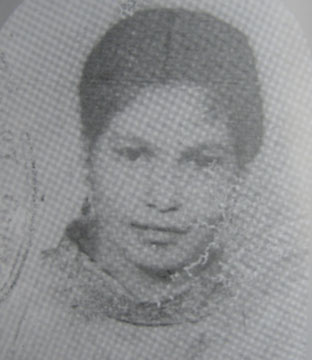
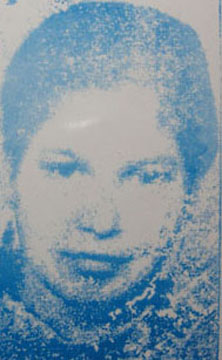 A
quarter century after Sumintra, we arrive at the same village,
at the same estate and have the same situation; death of a woman,
Kowsilla (or Alice) and hardly anything substantially recorded
about her. There has been no serious attempt by anyone, government
or otherwise, to recreate as best as possible, the life of this
woman who sacrificing her life in support of her position in an
industrial strike against the colonial sugar masters. And, as
if it takes forty years to revisit these scenes, forty years after
Kowsilla was killed by Felix Barr (who was acquitted
by a jury at the Assizes), I revisited the scene of the historic
estate workers’ resistance.
A
quarter century after Sumintra, we arrive at the same village,
at the same estate and have the same situation; death of a woman,
Kowsilla (or Alice) and hardly anything substantially recorded
about her. There has been no serious attempt by anyone, government
or otherwise, to recreate as best as possible, the life of this
woman who sacrificing her life in support of her position in an
industrial strike against the colonial sugar masters. And, as
if it takes forty years to revisit these scenes, forty years after
Kowsilla was killed by Felix Barr (who was acquitted
by a jury at the Assizes), I revisited the scene of the historic
estate workers’ resistance.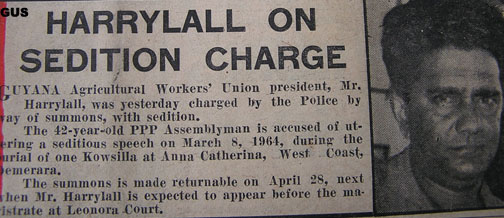 Kowsilla
would have known of all the important stories filtering through
the estate in March 1964; of who had been killed in the neighboring
villages such as Uitvlugt where the “Casbah” had become
very notorious. She would have known about all the sugar protest
being staged nationwide, which, according to Dr. Cheddi Jagan,
began on February 17 to demand recognition for GAWU from the Sugar
Producers’ Association. She would have heard people speak
of the PPP
Kowsilla
would have known of all the important stories filtering through
the estate in March 1964; of who had been killed in the neighboring
villages such as Uitvlugt where the “Casbah” had become
very notorious. She would have known about all the sugar protest
being staged nationwide, which, according to Dr. Cheddi Jagan,
began on February 17 to demand recognition for GAWU from the Sugar
Producers’ Association. She would have heard people speak
of the PPP
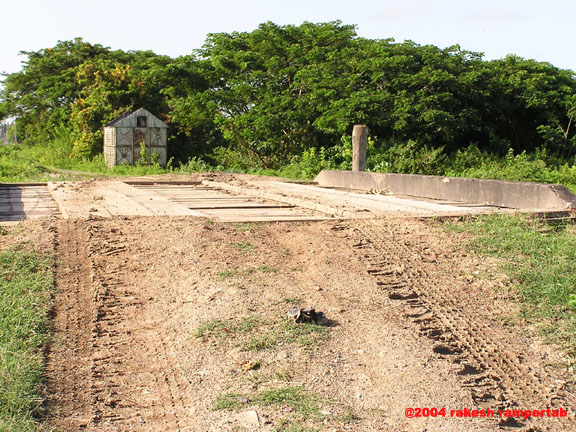
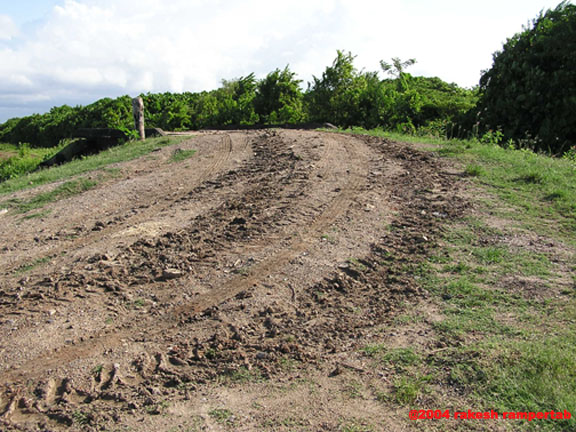
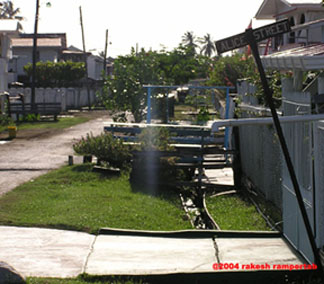
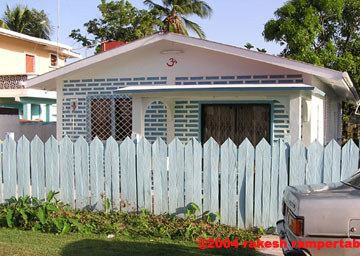
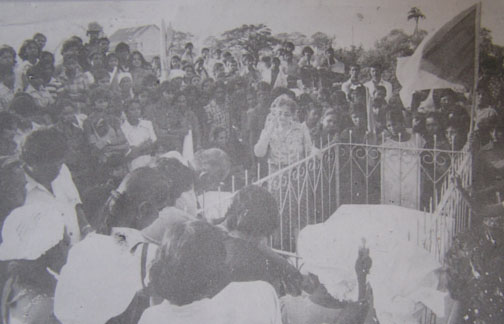 Gravesite
of Kowsilla at CI, West Coast Demerara.
Gravesite
of Kowsilla at CI, West Coast Demerara.